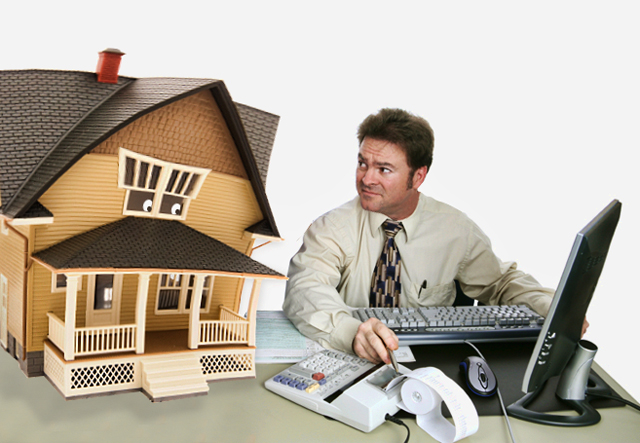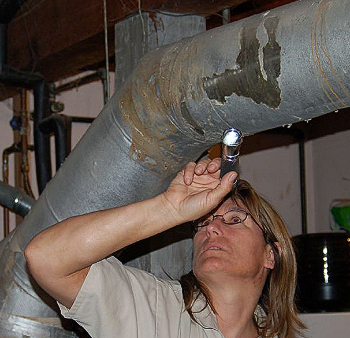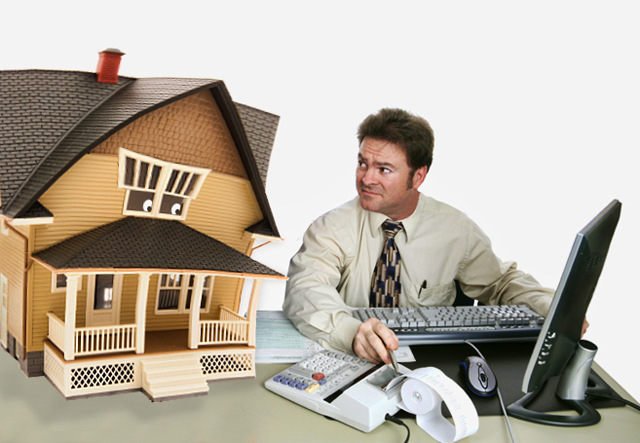 Photo illustration by Tom Twigg / Grist
Photo illustration by Tom Twigg / Grist
The red Honda Fit from a local car-sharing service pulls into the driveway of a suburban San Francisco Bay-area home, and two clean-cut young guys in khaki jump out and start unloading a Ghostbusters array of gadgets — something resembling a giant black megaphone, a glowing tube attached to a video screen, and a handheld device that looks like it was pilfered from Dr. McCoy’s sick bay.
Meet the “greenup” team from Sustainable Spaces, a four-year-old San Francisco firm that conducts residential energy audits and energy efficiency retrofits to shrink a home’s carbon footprint while saving the owner money over the long haul.
 Matt Golden of Sustainable Spaces sets up a large fan inside the home’s front door. When the fan is turned on, the house will be pressurized and the team will measure where the air is leaking out.KQED Quest via FlickrGreen retrofits are all the rage and for a reason: commercial and residential buildings account for more than 40 percent of greenhouse gas emissions in the United States. Insulating homes, plugging leaky heating ducts and taking other low-tech measures could cut energy use appreciably, which is why the Obama administration wants to retrofit all 128 million U.S. homes and has devoted billions of stimulus package cash to weatherization and other energy efficiency programs.
Matt Golden of Sustainable Spaces sets up a large fan inside the home’s front door. When the fan is turned on, the house will be pressurized and the team will measure where the air is leaking out.KQED Quest via FlickrGreen retrofits are all the rage and for a reason: commercial and residential buildings account for more than 40 percent of greenhouse gas emissions in the United States. Insulating homes, plugging leaky heating ducts and taking other low-tech measures could cut energy use appreciably, which is why the Obama administration wants to retrofit all 128 million U.S. homes and has devoted billions of stimulus package cash to weatherization and other energy efficiency programs.
So what has largely been an unregulated mom-and-pop business needs to scale up — big time — and homeowners need incentives to invest in insulation and other unglamorous improvements. Sustainable Spaces’ solution: Silicon Valley-style technological innovation coupled with heavy-duty politicking in Washington. More on that later.
At the 1950s ranch house in the East Bay ‘burb of Walnut Creek, energy auditor Ryan Jaramillo is explaining to homeowner Dan Schoenholz the company’s holistic home approach that treats a house as a networked energy system so that solutions can be prioritized to get the most bang for the buck. About half of greenups — Sustainable Spaces slang for energy audits — result in retrofits, Jaramillo says, and the company itself performs 90 percent of that work.
The 40-something, Prius-driving Shoenholz is a prototypical green retrofit client. He already had replaced many of his old single-pane windows. And Shoenholz, who deals with energy efficiency programs as a special projects manager for an East Bay city, rarely runs his air conditioner, even in Walnut Creek’s sweltering summers. He even participates in a PG&E program that lets the utility remotely turn off the AC when electricity demand spikes.
And he was willing to shell out about $300 for a Sustainable Spaces greenup, which usually runs $595 for a comparably sized house.
While Jaramillo strapped on a face mask and hoisted himself into the attic to inspect the ductwork and insulation, a colleague began measuring each room in the house, noting the placement of heating vents while using a gadget to determine the energy efficiency of the windows. Jaramillo then donned a jumpsuit and crawled into the crawl space, poking a gadget into the woodwork that measures moisture content.
Back in the house, Jaramillo fed a cable containing a miniature camera into the walls to see if they were insulated. Then it was time for the blower test. The front door was sealed and a blower used to depressurize the house so the greenup team could identify air leaks. Waving around an infrared sensor device, Jaramillo could see heat leaks showing up on the screen as orange-red sunbursts.
All the data collected at Schoenholz’s home will be fed into Sustainable Space’s computer models to guide its engineers’ design of an energy efficiency plan.
“One of the things that has prevented me from doing this stuff is that there’s a huge capital investment for a relatively small return,” Schoenholz says, “though I know it’s the right thing to do.”
The relatively paltry tax incentives for energy efficiency retrofits is the reason Sustainable Spaces founder and president Matt Golden spends at least one week a month in Washington. “We really didn’t get our act together for the stimulus and we kind of missed that boat to some degree,” Golden tells me a few days later in San Francisco. “Sexiness-wise, we don’t sound byte and we don’t have a pretty picture of a solar panel.”
While many billions will be handed out to weatherize low-income housing and promote other energy efficiency measures, not much was put in the pot for the average middle-class homeowner — Sustainable Spaces’ bread and butter customers. Install a $30,000 solar array on your roof and you qualify for a 30 percent tax credit — $9,000. But spend $30,000 on maximizing your home’s energy efficiency and the credit tops out at $1,500.
Golden, who serves as president of the new home-retrofit trade group Efficiency First, has been lobbying Congress to make tax credits dependent on how much energy a retrofit saves, not on the price of the products installed. Efficiency First also wants federal loan guarantees and low-interest financing for home retrofits. Golden is also working with state and local officials on how stimulus money will be distributed and for what programs.
 Pam Molsick of Sustainable Spaces inspects heating ducts insulated with asbestos, which is badly peeling in places.KQED Quest via FlickrBut Golden is depending on technological innovation to transform a cottage industry into big business. Sustainable Spaces, for instance, has an eight-person software division developing programs to automate the energy audit and retrofit process. (The company’s VP of product development is a former Google engineering director.)
Pam Molsick of Sustainable Spaces inspects heating ducts insulated with asbestos, which is badly peeling in places.KQED Quest via FlickrBut Golden is depending on technological innovation to transform a cottage industry into big business. Sustainable Spaces, for instance, has an eight-person software division developing programs to automate the energy audit and retrofit process. (The company’s VP of product development is a former Google engineering director.)
“We’re building a system that gives customers access to the data the same way we access the data, accelerates the process and also deploys systems on handhelds out in the field,” says Golden. “Very rapidly we need to deliver the tools that enable scale in this industry — through whatever means necessary because that’s how we get to our climate goals.”
And Efficiency First is pushing government to regulate the retrofit industry to avoid a backlash if unscrupulous operators flood the field in search of quick cash. “There’s more stringent standards in California for cutting hair than doing an energy audit,” Golden says.
Which is why I wasn’t surprised the other day when I was walking to the Berkeley farmers market to find a person handing out flyers for — you guessed it — home energy audits.
Read past Green State installments by Todd Woody.



